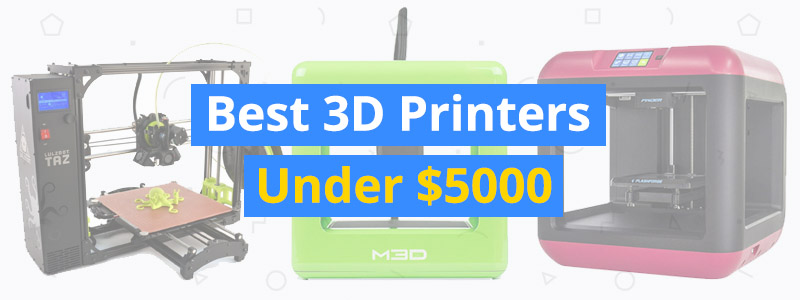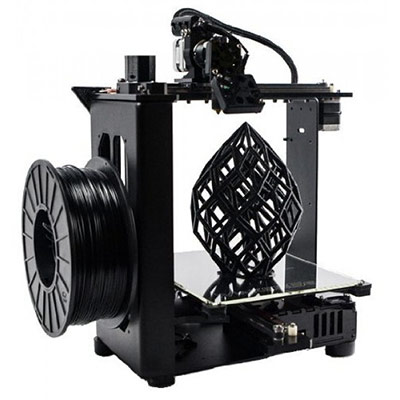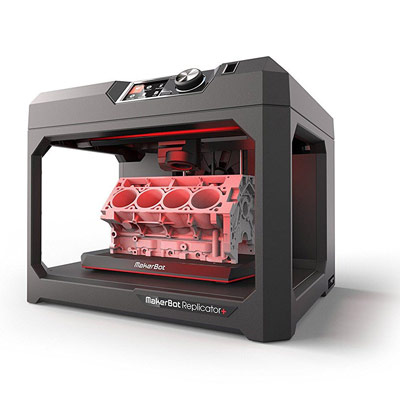Best 3D Printers Under $5000
It must be frustrating to sit there with a $5000 budget and not know where to begin your shopping process.
We know that shopping for 3D printers isn’t the easiest job in the world. The market is simply full of copycats and products that should have never been conceived in the first place. Just one wrong turn and you could easily end up with a crappy 3D printer that will never be worth $5000.
We’re here to help. In this guide on the best 3D printers under $5000, we introduce you to the only 3D printers that you should seriously consider. Note that we set our price minimum to $1000 because we don’t want to wander into cheap territory.
| Budget |
|---|
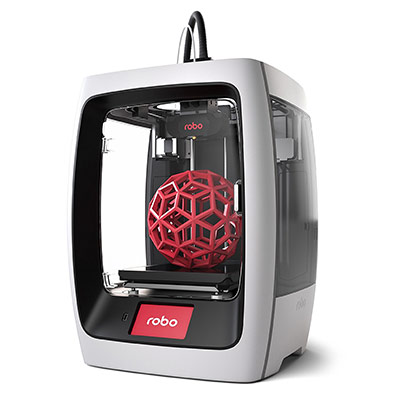 |
| ROBO 3D R2 |
| 4.6/5.0 |
| Wi-Fi, USB |
| 30.2 lb |
| Camera for remote monitoring and touchscreen interface. |
| Check Amazon |
| Best Value |
|---|
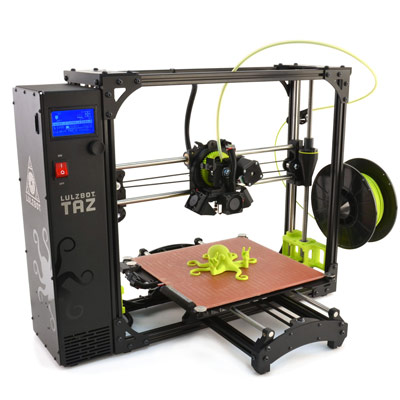 |
| LULZBOT TAZ 6 |
| 4.8/5.0 |
| USB, SD card |
| 33 lb |
| Low noise level and user-friendly default software. |
| Check Amazon |
| Top Pick |
|---|
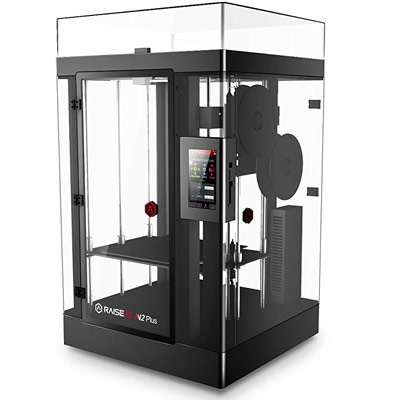 |
| RAISE3D N2 PLUS |
| 4.9/5.0 |
| Wi-Fi, USB, SD card |
| 143.3 lb |
| Low noise level while printing and Print resume feature. |
| Check Amazon |
We have sorted our top picks in the table below to make it easier to choose one.
Best 3D Printers Under $5000 Comparison Table
| Make and Model | Weight | Connectivity | Price |
|---|---|---|---|
| Raise3D N2 Plus | 143.3 lb | Wi-Fi, USB, SD card | Check Price |
| Robo 3D R2 | 30.2 lb | Wi-Fi, USB | Check Price |
| LulzBot TAZ 6 | 33 lb | USB, SD card | Check Price |
| MakerGear M2e | 26.5 lb | USB, SD card | Check Price |
| MakerBot Replicator Plus | 40.4 lb | Wi-Fi, USB | Check Price |
1. Raise3D N2 Plus
Editor’s Rating: 4.9/5
If you can afford to spend $5000 on a 3D printer, you might as well buy the biggest of them all. Forget about large 3D printers that boast a 10-inch maximum allowable build height. Go for a 3D printer that more than doubles that limit.
Introducing the Raise3D N2 Plus, the best 3D printer that you can get for less than $5000. It’s a 3D printer with a massive build size, towering over other large 3D printers on the market – including the popular MakerBot Replicator Z18 and the second-tallest 3D printer on this list, the Robo 3D R2.
The N2 Plus is a fully enclosed 3D printer. It’s housed in a sturdy aluminum frame with a see-through cover that allows you to quickly check your progress. Everything is secured inside the enclosure, with no dangerously protruding parts and messy wires to get snagged on.
It’s only natural that the N2 Plus sports a larger-than-normal onboard interface. It’s got a 7-inch touchscreen interface right beside the door. It’s responsive, easy to navigate, and includes straightforward options that beginners can easily understand. Overall, the N2 Plus’s design is clean, robust, functional, and aesthetically pleasing.
Setting up the N2 Plus is quick and easy. It arrives mostly assembled. Just attach a few parts here and there and you can call it a day. Imagine how stressful it would be if you have to put it together all the way from scratch. Including the software configuration, the initial setup should only take about one hour, probably less if you already know your way around 3D printers.
The N2 Plus’s colossal build size isn’t the only thing that makes it stand out. It’s also notable for having arguably the prettiest print quality in this class. At optimum settings, the N2 Plus is capable of producing gorgeous and polished 3D models that can make you wonder why you didn’t buy it sooner.
Boasting a dual extruder setup (a single extruder setup is also available), the N2 Plus is a reliable workhorse that can print non-stop for days with consistent results. And you don’t have to worry about a power outage interrupting your progress and forcing you to start all over again. The N2 Plus includes a resume feature that allows it to continue where it left off.
The N2 Plus is also notable for being one of the quietest 3D printers in this class, which is uncommon for a large 3D printer. It doesn’t produce loud mechanical noises while printing. It just sits in the corner and works in silence. Compared to other large 3D printers, the N2 Plus is like a 3D printing assassin that works with precision and efficiency while barely registering a sound in the room.
In a market full of 3D printers claiming to be compatible with various types of filaments, the N2 Plus stands out as one of the few that actually delivers on the promise. It can work with different types of materials, including ABS, PLA, HIPS, PETG, and TPU. It’s compatible with third-party filaments as well, so feel free to use filaments from Hatchbox and other popular brands.
In our best large 3D printers buyer’s guide, we held off on making the N2 Plus our top overall pick. We reasoned that it was too expensive for most people. Now that we’re talking about a $5000 budget, we can now give it the crown that it deserves. It is without a doubt the best 3D printer that you can get for less than $5000.
| Tech Specs |
|---|
| Resolution: 10 microns |
| Volume: 12 x 12 x 24 in |
| Filament: 1.75 mm |
| Type: ABS, PLA, PETG, and others |
| Weight: 143.3 lb |
| Connect: Wi-Fi, USB, SD card |
| The Pros |
|---|
| Enormous maximum build size |
| Fantastic print quality across the board |
| Fully enclosed for temperature consistency |
| Easy to set up and requires minimal calibration |
| Print resume feature |
| Easy-to-use touchscreen interface |
| Low noise level while printing |
| Excellent documentation and customer support |
| The Cons |
|---|
| Default software isn’t the most beginner-friendly |
2. Robo 3D R2
Editor’s Rating: 4.6/5
The Robo 3D R2 is one of those 3D printers that can easily sell for double their listed price and walk away without being called “overpriced.” It’s that good. So you might want to pick it up before Robo 3D suddenly decides to jack up the price because it’s too much of a steal.
Born from a successful Kickstarter campaign, the R2 is a large 3D printer that looks like a miniaturized time machine straight out of a sci-fi film. It’s enclosed on all sides except at the top, where the filament goes in from the spool holder at the back. But even with the uncovered top, the R2’s temperature regulating ability is still on point.
The R2 arrives nearly assembled, with only a few parts that need to be installed. It’s got a heated build plate, which should be good news for anyone who wants to play around with ABS. In addition, the build plate has excellent adhesion by default, so you don’t have to resort to tricks like using glue or tape. The R2 also features a built-in camera inside, which allows for remote monitoring.
The R2’s most impressive feature is the 5-inch touchscreen interface positioned at the base of the machine. It’s not just an interface. It’s a one-stop hub that lets you do a number of things that make 3D printing hassle-free and convenient.
Most notably, the touchscreen interface includes a slicing software that allows you to prepare your 3D models without the aid of a computer. The onboard slicing software is not exactly the full package, but it’s good enough for basic tasks. It’s also possible to load saved 3D models from the touchscreen interface, courtesy of the R2’s built-in memory that can store hundreds of files.
Lastly, with the touchscreen interface, you can easily start, stop, and pause prints. The pause option is especially useful because it allows you to continue your progress in case the loaded filament comes up short. On a related note, the R2 is equipped with a filament run-out detector, so you’ll never be caught off guard.
Performance-wise, the R2 is exactly as advertised. It’s got excellent print quality, prints fairly fast, and can use a wide range of filaments, including ABS, PLA, flexible, nylon, and wood. It boasts a generous build size, allowing you to expand your horizons and take on more ambitious projects.
Our biggest gripe about the R2 is that it’s very loud while printing. Seriously, it’s really loud, so don’t even think about having it in your room so you can geek out over it while it’s printing. Remember, it’s possible to monitor it from a distance, courtesy of the built-in camera and the wireless connectivity.
If you want the best “budget” 3D printer in this price range, the R2 – which retails for just under $1500 – should be your one and only choice. It’s a reliable 3D printer that puts a premium on convenience and ease-of-use. It ships with everything you need to get started right away.
| Tech Specs |
|---|
| Resolution: 20 microns |
| Volume: 8 x 8 x 10 in |
| Filament: 1.75 mm |
| Type: ABS, PLA, Nylon, and others |
| Weight: 30.2 lb |
| Connect: Wi-Fi, USB |
| The Pros |
|---|
| Easy to use |
| Excellent print quality |
| Compatible with third-party filaments |
| Generous build size for the prize |
| Intuitive touchscreen interface |
| Onboard slicer and built-in memory |
| Integrated camera for remote monitoring |
| Filament run-out detection and resume capability |
| The Cons |
|---|
| High noise level |
| Not fully enclosed on all sides |
3. LulzBot TAZ 6
Editor’s Rating: 4.8/5
If you’re a tinkerer, you need a 3D printer that you can play around with and modify however you want. No machine in this price range is more open for tinkering than the LulzBot TAZ 6, one of the most popular 3D printers around.
The TAZ 6 is an open-framed 3D printer that arrives mostly assembled. No need to assemble it from the ground up, although it appears to be a DIY 3D printer based on promotional images. It is held together by a sturdy aluminum frame that keeps it steady while printing. It includes an onboard interface, located at the top of the power box. It’s just a basic LCD interface, though, so don’t expect too much out of it.
Similar to the LulzBot Mini, the TAZ 6 requires minimal tinkering during the initial setup process. Bed leveling is a breeze and software installation is quick and easy. It takes about one hour to get it out of the box, install the detached parts, go through the initial configuration, and load the starter filament. If you have previous experience with 3D printers, especially DIY 3D printers, setting up the TAZ 6 should only take about 30 minutes.
One of the chief reasons why the TAZ 6 is so easy to set up is the included instruction manual. It’s one of the most complete and detailed instruction manuals we have ever seen in this price range. It’s actually possible to go through the initial setup without watching help videos on YouTube, and that’s really saying something.
Once you manage to get your TAZ 6 up and running, everything should be a walk in the park. It’s easy to use, featuring a user-friendly custom Cura software that allows you to print your first 3D model in just a few minutes. But if you think the default software is too limited for your taste, you can to switch to a more versatile software (hello, Simplify3D) as soon as you can, which brings us to our next point.
The TAZ 6 is completely open-source. So feel free to make changes to the hardware and software for the sake of learning and/or improvement. The best part is that you can find lots of modding guides on the internet that can help you bring out the best out of your TAZ 6.
The TAZ 6’s print quality is superb. It’s on the same level as the MakerGear M2e. It’s clean, smooth, and consistent all around. The TAZ 6 is compatible with various filament types. It can print PLA, ABS, HIPS, PVA, and nylon, among others. It’s not the best at maintaining temperature, though, which is a common issue among non-enclosed 3D printers.
All in all, the TAZ 6 is a well-built 3D printer that brings excellent value to the table. It’s ideal for tinkerers and intermediate users. It’s not exactly rich in features compared to the Robo 3D R2 and the Raise3D N2 Plus, but it gets the job done right. If you want a 3D printer that can grow with you while you learn the ups and downs of 3D printing, the TAZ 6 is for you.
| Tech Specs |
|---|
| Resolution: 50 microns |
| Volume: 11 x 11 x 9.8 in |
| Filament: 3 mm |
| Type: ABS, PLA, HIPS, and others |
| Weight: 33 lb |
| Connect: USB, SD card |
| The Pros |
|---|
| Open-source hardware and software |
| Quick and easy initial setup |
| Detailed instruction manual |
| User-friendly default software |
| Superb print quality |
| Large build size |
| Low noise level for an open-framed 3D printer |
| Excellent technical support |
| The Cons |
|---|
| No enclosure |
| Rudimentary built-in interface |
| Not Wi-Fi compatible |
4. MakerGear M2e
Editor’s Rating: 4.7/5
Not impressed by the LulzBot TAZ 6? If you want the second-best open-framed 3D printer in this price range, look no further than the MakerGear M2e. It’s similar to the TAZ 6 in almost every way, with only a few differences that prevent it from being our pick for Best Value.
Like the TAZ 6, the M2e arrives mostly assembled. It’s similarly easy to set up, with the initial configuration only lasting about 30 minutes, maybe less for 3D printing veterans. It’s got everything you need to get started right away.
The M2e’s print quality is on par with the TAZ 6’s. It’s polished, accurate, and detailed. If you buy both and print the same items in the exact same settings and material, you probably won’t be able to tell which is which. The M2e is also equipped with a heated build plate and is perfectly capable of working with various filament types, including ABS, Flexible, and PETG.
Now, let’s talk about what makes the M2e different from the TAZ 6. If you paid attention to the comparison table above, the first thing you’ll notice is that the MakerGear M2e has a smaller build volume than the TAZ 6. It’s still larger than many other 3D printers in this class, though, so it’s not exactly hovering in the mini 3D printer category. The M2e’s smaller build plate is the main reason why we ruled in favor of the TAZ 6.
The M2e is noisier than the TAZ 6. It’s not ear-splittingly noisy. It’s just that the moving parts give off more pronounced mechanical sounds, which can annoy the hell out of you if you have the M2e on your work desk. It’s best to keep it in a separate room, preferably in a well-enclosed room because in case you haven’t noticed, the M2e is open-framed, which means it’s vulnerable to dust.
The M2e’s instruction manual is not on the same level as the TAZ 6’s. It’s less detailed and can be confusing in some areas. It’s not exactly an earth-shattering issue, but we still wanted to point it out so beginners know what to expect from the M2e’s instruction manual.
Just like the TAZ 6, the M2e is an open-source 3D printer, which means you get to experiment with the hardware and software once you’re ready to do a bit of modding. It’s easy to find customization guides on the internet, courtesy of the M2e’s active community.
For the best results right off the bat, we recommend that you replace the M2e’s default software with the Simplify3D or other more versatile printing software. Since you have a $5000 budget, and the M2e sits way below the price ceiling, you can afford to buy a better printing software. If you’re not cool with that, you can always use free software.
Although the TAZ 6 is better than it in almost every way, the M2e is still a top-notch 3D printer that’s head and shoulders above other products in this price range. In fact, it’s our top overall pick in our guide on the best 3D printers under $2000. If you’ve got issues with the TAZ 6, pick up the M2e and forget about the rest of the field.
| Tech Specs |
|---|
| Resolution: 50 microns |
| Volume: 8 x 10 x 8 in |
| Filament: 1.75 mm |
| Type: ABS, PLA, HIPS, and others |
| Weight: 26.5 lb |
| Connect: USB, SD card |
| The Pros |
|---|
| Large print size |
| Fantastic print quality |
| Easy to set up |
| Sturdy and stable construction |
| Easy to calibrate |
| Excellent after-sales support |
| Open-source hardware and software |
| Pairs flawlessly with Simplify3D |
| The Cons |
|---|
| Non-enclosed |
| Noisy |
| Instruction manual could be improved |
5. MakerBot Replicator Plus
Editor’s Rating: 4.4/5
MakerBot is one of the most recognizable brands in the business. Lots of 3D printers under $1000 are clones of MakerBot’s products, and the Replicator Plus is just the latest that’s sure to give birth to countless copycats in the future.
The Replicator Plus is an open-framed 3D printer housed in a glossy casing. It’s got that unmistakable high-end look that pretty much screams “I’m expensive!” It includes an onboard camera on one of the pillars and a nice built-in spool holder at the back. It sports a full-color LCD interface, which seems really cool at first until you realize it’s operated by a knob.
In terms of design, the Replicator Plus carries that same professional aura exuded by other MakerBot 3D printers. It’s a robust machine that looks good on any desk, although we don’t recommend that you place it in your room or work desk since it can be really loud and annoying.
The Replicator Plus is designed to make 3D printing hassle-free and convenient, especially for beginners. It arrives mostly assembled. Connecting all the detached parts should only take you a few minutes. The initial setup is even easier. It sets up through the MakerBot app on your smartphone, which you obviously need to download first, along with the MakerBot printing software.
Once the Replicator Plus is set up, the next thing you should do is check out MakerBot Print, MakerBot’s own printing software. It’s a user-friendly software with basic and straightforward options. Unless you have serious issues with program navigation, you should have no trouble understanding MakerBot Print.
The Replicator Plus prints with a level of accuracy and smoothness that can make most copycats jealous. It’s capable of popping out print after print with minimal issues. It prints faster than the 5th-gen Replicator. The maximum build size is larger, too.
The build plate is not heated. It’s not really a deal-breaker considering the Replicator Plus is limited to only PLA and tough PLA filaments, which don’t require a heated print bed. Speaking of filaments, the Replicator Plus isn’t the most accommodating in that regard.
It’s optimized for MakerBot’s expensive filaments. If you need physical proof of that, you only need to look at the built-in spool holder. It’s designed specifically for MakerBot’s spool of filaments, so spools from third-party brands will have a tough time fitting inside. If you want to use third-party filaments, you need to print your own external spool holder.
But we recommend that you just stick to MakerBot’s filaments – and we’ve got two reasons why you should listen to us on this one. First, using third-party filaments will immediately void your machine’s warranty, which is not good. Second, the MakerBot printing software and the extruder are optimized for MakerBot’s own filaments. So, yeah, forget about third-party filaments.
Despite its limitations, the Replicator Plus still brings enough value to the table to make it one of the best 3D printers under $5000. It’s got a filament run-out detector and the ability to automatically pause printing once it detects a filament jam, saving you from the messy aftermath that comes with stuck filaments. Not many 3D printers can boast those two features, even in this price range.
| Tech Specs |
|---|
| Resolution: 100 microns |
| Volume: 11.6 x 7.6 x 6.5 in |
| Filament: 1.75 mm |
| Type: PLA, Tough PLA |
| Weight: 40.4 lb |
| Connect: Wi-Fi, USB |
| The Pros |
|---|
| Intuitive app-guided initial setup |
| Easy to use |
| User-friendly software |
| Onboard camera for remote monitoring |
| Large build plate |
| Prints faster than predecessor |
| Filament jam detection and auto-pause |
| Filament run-out notifications |
| Reliable customer support |
| The Cons |
|---|
| Limited to PLA and Tough PLA |
| No heated build plate |
| Built-in spool holder not compatible with third-party spools |
| Needs MakerBot filaments for best results |
Contents

